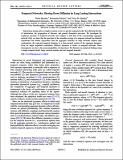Por favor, use este identificador para citar o enlazar a este item:
http://hdl.handle.net/10261/116413COMPARTIR / EXPORTAR:
 SHARE SHARE
 CORE
BASE CORE
BASE
|
|
| Visualizar otros formatos: MARC | Dublin Core | RDF | ORE | MODS | METS | DIDL | DATACITE | |

| Campo DC | Valor | Lengua/Idioma |
|---|---|---|
| dc.contributor.author | Masuda, Naoki | - |
| dc.contributor.author | Klemm, Konstantin | - |
| dc.contributor.author | Eguíluz, Víctor M. | - |
| dc.date.accessioned | 2015-06-11T09:13:55Z | - |
| dc.date.available | 2015-06-11T09:13:55Z | - |
| dc.date.issued | 2013-10-29 | - |
| dc.identifier.citation | Physical Review Letters 111(18): 188701 (2013) | es_ES |
| dc.identifier.issn | 0031-9007 | - |
| dc.identifier.uri | http://hdl.handle.net/10261/116413 | - |
| dc.description.abstract | Interactions among units in complex systems occur in a specific sequential order, thus affecting the flow of information, the propagation of diseases, and general dynamical processes. We investigate the Laplacian spectrum of temporal networks and compare it with that of the corresponding aggregate network. First, we show that the spectrum of the ensemble average of a temporal network has identical eigenmodes but smaller eigenvalues than the aggregate networks. In large networks without edge condensation, the expected temporal dynamics is a time-rescaled version of the aggregate dynamics. Even for single sequential realizations, diffusive dynamics is slower in temporal networks. These discrepancies are due to the noncommutability of interactions. We illustrate our analytical findings using a simple temporal motif, larger network models, and real temporal networks. Published by American Physical Society. | es_ES |
| dc.description.sponsorship | We also acknowledge financial support provided by Grants-in-Aid for Scientific Research (No. 23681033) from MEXT, Japan, the Nakajima Foundation, VolkswagenStiftung, and MINECO (Spain) and FEDER (EU) through the MODASS Project (No. FIS2011-24785). | es_ES |
| dc.language.iso | eng | es_ES |
| dc.publisher | American Physical Society | es_ES |
| dc.relation.isversionof | Publisher's version | es_ES |
| dc.rights | openAccess | es_ES |
| dc.title | Temporal networks: Slowing down diffusion by long lasting interactions | es_ES |
| dc.type | artículo | es_ES |
| dc.identifier.doi | 10.1103/PhysRevLett.111.188701 | - |
| dc.description.peerreviewed | Peer reviewed | es_ES |
| dc.relation.publisherversion | http://dx.doi.org/10.1103/PhysRevLett.111.188701 | es_ES |
| dc.identifier.e-issn | 1079-7114 | - |
| dc.rights.license | http://creativecommons.org/licenses/by/3.0/ | es_ES |
| dc.contributor.funder | Volkswagen Foundation | - |
| dc.contributor.funder | Ministry of Education, Culture, Sports, Science and Technology (Japan) | - |
| dc.contributor.funder | Heiwa Nakajima Foundation | - |
| dc.contributor.funder | Ministerio de Economía y Competitividad (España) | - |
| dc.contributor.funder | European Commission | - |
| dc.relation.csic | Sí | es_ES |
| dc.identifier.funder | http://dx.doi.org/10.13039/501100001700 | es_ES |
| dc.identifier.funder | http://dx.doi.org/10.13039/501100003485 | es_ES |
| dc.identifier.funder | http://dx.doi.org/10.13039/501100003329 | es_ES |
| dc.identifier.funder | http://dx.doi.org/10.13039/501100000780 | es_ES |
| dc.type.coar | http://purl.org/coar/resource_type/c_6501 | es_ES |
| item.openairecristype | http://purl.org/coar/resource_type/c_18cf | - |
| item.fulltext | With Fulltext | - |
| item.cerifentitytype | Publications | - |
| item.openairetype | artículo | - |
| item.languageiso639-1 | en | - |
| item.grantfulltext | open | - |
| Aparece en las colecciones: | (IFISC) Artículos | |
Ficheros en este ítem:
| Fichero | Descripción | Tamaño | Formato | |
|---|---|---|---|---|
| temporal_networks_Masuda.pdf | 194,79 kB | Adobe PDF |  Visualizar/Abrir |
CORE Recommender
SCOPUSTM
Citations
95
checked on 16-abr-2024
WEB OF SCIENCETM
Citations
94
checked on 25-feb-2024
Page view(s)
366
checked on 18-abr-2024
Download(s)
274
checked on 18-abr-2024
Google ScholarTM
Check
Altmetric
Altmetric
Este item está licenciado bajo una Licencia Creative Commons

